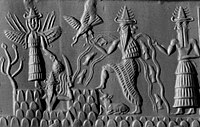Ninshubur
| Ninshubur 𒀭𒊩𒌆𒋚 | |
|---|---|
 Ancient Akkadian cylinder seal depicting Inanna resting her foot on the back of a lion while Ninshubur stands in front of her paying obeisance, c. 2334-2154 BC[1] |
Ninshubur (𒀭𒊩𒌆𒋚, also known as Ninshubar, Nincubura or Ninšubur)[2] was the sukkal or second-in-command of the goddess Inanna in Sumerian mythology. Her name means "Queen of the East" in ancient Sumerian. Much like Iris or Hermes in later Greek mythology, Ninshubur served as a messenger to the other gods.
Ninshubur accompanied Inanna as a vassal and friend throughout Inanna's many exploits. She helped Inanna fight Enki's demons after Inanna's theft of the sacred me. Later, when Inanna became trapped in the Underworld, it was Ninshubur who pleaded with Enki for her mistress's release.
Gender[edit]
In later Akkadian mythology, Ninshubur was syncretized with the male messenger deity Papsukkal.[3][4] In older sources, Ninshubur herself is usually referred to as a male god as well;[5] more recent sources have recognized this portrayal as erroneous.[5] The gender of a sukkal always matches the gender of the deity it serves.[5] Thus, Enki's sukkal Isimud is male, but Ninshubur is female.[5] In her primary aspect as the sukkal to Inanna, Ninshubur was female,[6] but, when she served as the sukkal to An, he was male.[4]
Iconography[edit]
Ninshubur was associated with the constellation Orion.[4]
Character[edit]
In Sumerian mythology, Ninshubur is portrayed as "unshakably loyal" in her devotion to her mistress.[7] In addition to being a source of great wisdom and knowledge,[7] Ninshubur was also a warrior goddess.[7] She was the guardian and messenger of the god An.[7] She is said to have walked in front of An wherever he went, a position traditionally reserved for a bodyguard.[7]
Mythology[edit]
Ninshubur was an important figure in ancient Sumerian mythology and she played an integral role in several myths involving her mistress, the goddess, Inanna.
Theft of the Mes[edit]
In the Sumerian myth of "Inanna and Enki," Ninshubur is described as the one who rescues Inanna from the monsters that Enki has sent after her.[8][9][7] In this myth, Ninshubur plays a similar role to Isimud, who acts as Enki's messenger to Inanna.[7]
Inanna's descent to the Underworld[edit]
In the Sumerian myth of Inanna's descent into the Netherworld, Ninshubur is described as the one who pleads with all the gods in an effort to persuade them to rescue Inanna from the Netherworld.[10][11]
References[edit]
- ^ Wolkstein & Kramer 1983, pp. 92, 193.
- ^ "Sumerian Dictionary". oracc.iaas.upenn.edu.
- ^ Jordan 2002.
- ^ a b c Black & Green 1992, p. 141.
- ^ a b c d Wolkstein 1983.
- ^ Black & Green 1992, p. 142.
- ^ a b c d e f g Pryke 2017, p. 94.
- ^ Kramer 1961, pp. 67-68.
- ^ Wolkstein & Kramer 1983, pp. 20-27.
- ^ Kramer 1961, pp. 92-94.
- ^ Wolkstein & Kramer 1983, pp. 61-63.
Bibliography[edit]
- Black, Jeremy; Green, Anthony (1992), Gods, Demons and Symbols of Ancient Mesopotamia: An Illustrated Dictionary, The British Museum Press, ISBN 0-7141-1705-6
- Jordan, Michael (2002), Encyclopedia of Gods, Kyle Cathie Limited
- Pryke, Louise M. (2017), Ishtar, New York and London: Routledge, p. 94, ISBN 978-1-138--86073-5
- Wolkstein, Diane; Kramer, Samuel Noah (1983), Inanna: Queen of Heaven and Earth: Her Stories and Hymns from Sumer, New York City, New York: Harper&Row Publishers, ISBN 0-06-090854-8
- Wolkstein, Diane (1983), "Sumerian Goddess", The New York Review of Books, The New York Review of Books
External links[edit]
| Wikiquote has quotations related to: Ninshubur |
 Media related to Ninshubur at Wikimedia Commons
Media related to Ninshubur at Wikimedia Commons- Ancient Mesopotamian Gods and Goddesses: Papsukkal (god)
- Various descriptions of Inanna and Ninshubur

